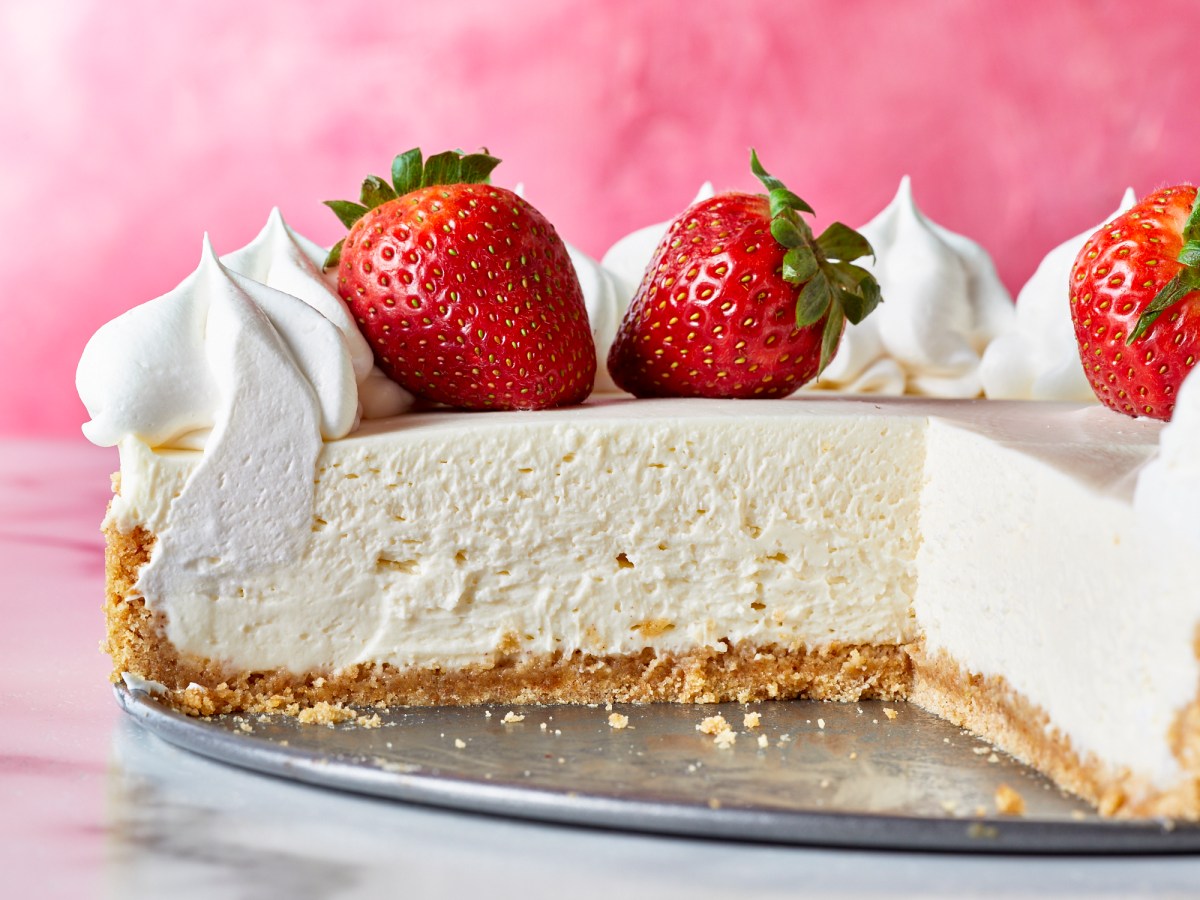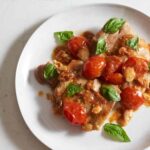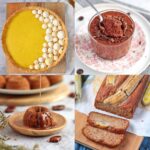Indulge in the rich, creamy texture of cheesecake without the eggs! This exploration delves into the art of crafting dreamy, delicious egg-free cheesecakes, unveiling a world of flavor variations and innovative techniques. Discover how simple substitutions transform classic recipes into delectable treats, perfect for those with egg allergies or those simply seeking a unique culinary adventure. Prepare to be amazed by the surprisingly smooth and decadent results achievable without relying on traditional egg-based recipes. We’ll explore diverse flavor profiles, from the classic New York style to decadent chocolate and vibrant fruit-infused creations, guiding you through every step of the process with precision and detail.
We’ll uncover the secrets to achieving the perfect texture using various egg substitutes, comparing applesauce, silken tofu, and mashed banana, revealing their unique impact on the final product. Learn the crucial steps for baking success, from the careful preparation of the filling to the importance of chilling for a flawless finish. Master ingredient substitutions, ensuring each swap maintains the creamy, dreamy essence of a classic cheesecake. Finally, we’ll elevate your presentation with stunning garnishing ideas and creative serving suggestions, transforming your egg-free masterpiece into a culinary showstopper.
Step-by-Step Baking Process

Creating a flawlessly smooth and creamy egg-free cheesecake requires careful attention to detail and a precise understanding of the ingredients’ interactions. This recipe relies on the stabilizing properties of cornstarch and the richness of cream cheese to achieve a texture comparable to traditional cheesecakes. The process involves several crucial steps that contribute to the final product’s delightful texture and flavor. Proper execution of each step is essential for a successful outcome.
This recipe will guide you through the creation of a classic egg-free cheesecake, highlighting the scientific reasons behind each step. Understanding these reasons will allow you to troubleshoot potential problems and consistently achieve delicious results. The focus will be on maintaining a stable structure without the use of eggs, which typically provide binding and leavening properties.
Preparing the Crust
The crust provides the foundation for your cheesecake, offering a delightful textural contrast to the creamy filling. A simple graham cracker crust is ideal, requiring minimal ingredients and preparation time. Pressing the crumbs firmly into the pan ensures a solid base that prevents cracking and provides structural support during baking.
- Combine 1 ½ cups graham cracker crumbs, ¼ cup granulated sugar, and 6 tablespoons melted unsalted butter in a medium bowl. Mix thoroughly until evenly moistened.
- Press the crumb mixture firmly into the bottom of a 9-inch springform pan. Use the bottom of a measuring cup or similar tool to create an even layer.
- Bake the crust at 350°F (175°C) for 8-10 minutes, or until lightly golden. This pre-baking step helps to solidify the crust and prevents it from becoming soggy from the filling.
Creating the Filling
The filling is the heart of the cheesecake, requiring careful attention to temperature and mixing techniques. Cream cheese needs to be softened to ensure smooth blending; over-mixing can incorporate too much air, leading to cracks. The cornstarch acts as a stabilizer, preventing the cheesecake from becoming watery or separating.
- In a large bowl, beat 3 (8-ounce) packages of softened cream cheese until smooth and creamy. The softened cream cheese is crucial for creating a homogenous mixture without lumps.
- Gradually add 1 ¾ cups granulated sugar, beating until fully incorporated. Adding the sugar gradually prevents clumping and ensures even sweetness throughout.
- Beat in 1 teaspoon vanilla extract and ¼ cup cornstarch. The cornstarch is vital for thickening the filling and preventing cracks during baking and cooling.
- In a separate bowl, whisk together 1 ½ cups heavy cream and 2 tablespoons lemon juice. Gently fold this mixture into the cream cheese mixture until just combined. Overmixing incorporates too much air, potentially leading to cracks in the finished cheesecake.
Baking and Cooling
The baking process requires a slow and steady approach to prevent cracking and ensure even cooking. A water bath helps to maintain a consistent oven temperature and prevent the cheesecake from drying out. The cooling process is equally important, as it allows the cheesecake to set properly.
- Pour the filling into the prepared crust. Place the springform pan in a larger roasting pan. Pour enough hot water into the roasting pan to come halfway up the sides of the springform pan. This creates a water bath, which helps to regulate oven temperature and prevent cracking.
- Bake at 325°F (160°C) for 50-60 minutes, or until the cheesecake is set around the edges but still slightly jiggly in the center. The center should still have a slight wobble to allow for setting during cooling.
- Turn off the oven and leave the cheesecake in the oven with the door slightly ajar for 1 hour. This gradual cooling prevents sudden temperature changes that can lead to cracks.
- Remove the cheesecake from the water bath and let it cool completely at room temperature. This slow cooling process is crucial for achieving a smooth, creamy texture and prevents cracking. Once cool, refrigerate for at least 4 hours, or preferably overnight, to allow the cheesecake to fully set.
Ingredient Substitutions and Alternatives
Creating a dreamy, delicious egg-free cheesecake requires careful consideration of ingredient substitutions. The right swaps will maintain the creamy texture and rich flavor we crave, even without eggs. This section explores viable alternatives for key cheesecake components, analyzing their impact on the final product.
Cream Cheese Alternatives
Cream cheese provides the cheesecake’s signature tang and creamy base. Fortunately, several alternatives can achieve similar results. Substituting cream cheese requires considering both flavor and texture.
| Original Ingredient | Substitute Options | Impact on Taste and Texture |
|---|---|---|
| Cream Cheese | Cashew Cream Cheese (soaked cashews blended with water and lemon juice), Tofu Cream Cheese (silken tofu blended with lemon juice and oil), Vegan Cream Cheese (store-bought options) | Cashew cream cheese offers a slightly nutty flavor and a smooth, creamy texture. Tofu cream cheese provides a neutral flavor and a similarly smooth texture, though it may be slightly less tangy. Store-bought vegan cream cheeses vary widely in taste and texture, so careful selection is crucial. |
Sugar Substitutes
Sugar contributes to both sweetness and structure in a cheesecake. Several alternatives can mimic its function, each with its unique properties.
| Original Ingredient | Substitute Options | Impact on Taste and Texture |
|---|---|---|
| Sugar (Granulated or Powdered) | Maple Syrup, Agave Nectar, Coconut Sugar, Stevia | Maple syrup adds a distinct caramel-like flavor and moisture. Agave nectar provides a mild sweetness and a slightly runny consistency. Coconut sugar offers a subtle caramel flavor and a slightly grainy texture. Stevia, a natural sweetener, is intensely sweet, requiring careful measurement to avoid an overly sweet result. |
Other Key Ingredient Substitutions
Beyond cream cheese and sugar, other components may require adjustments for an egg-free cheesecake. These substitutions focus on maintaining the desired texture and structure.
| Original Ingredient | Substitute Options | Impact on Taste and Texture |
|---|---|---|
| Eggs (for binding and richness) | Chia seeds (mixed with water to form a gel), Mashed Banana (adds moisture and binding), Applesauce (adds moisture and sweetness), Flaxseed Meal (mixed with water to form a gel) | Chia seeds and flaxseed meal provide a binding effect similar to eggs, though they might add a slight nutty flavor. Mashed banana and applesauce add moisture and sweetness, but can slightly alter the overall flavor profile. The quantity of these substitutes may need adjustment depending on the specific recipe. |
Presentation and Serving Suggestions
Transforming your egg-free cheesecakes from simple desserts into culinary masterpieces involves thoughtful presentation and clever serving suggestions. The right plating and garnishes can elevate the visual appeal, enhancing the overall dining experience and leaving a lasting impression. A beautifully presented cheesecake speaks volumes about the care and attention to detail invested in its creation.
The key to a stunning presentation lies in simplicity and elegance. Avoid overcrowding the plate, allowing the cheesecake’s creamy texture and rich color to shine. The right garnish can add a pop of color, texture, and flavor, complementing the cheesecake without overpowering it.
Garnishing Options
Three distinct garnishing options can dramatically enhance the visual appeal of your egg-free cheesecakes. Each option offers a unique textural and flavor profile, allowing you to customize the presentation to suit your preference and the occasion.
Option 1: Berry Burst
Imagine a pristine slice of cheesecake, its smooth surface adorned with a vibrant scattering of fresh raspberries, blueberries, and strawberries. The deep red of the raspberries contrasts beautifully with the deep purple of the blueberries, and the bright red of the strawberries adds a playful touch. A light drizzle of raspberry coulis, a luscious puree of raspberries, adds a glossy sheen and a tangy sweetness that perfectly complements the creamy cheesecake. The contrasting textures – the smooth cheesecake against the juicy berries – create a delightful sensory experience.
Option 2: Chocolate Elegance
For a more sophisticated presentation, consider a dusting of unsweetened cocoa powder, creating a rich, dark contrast against the pale cheesecake. Thinly shaved dark chocolate curls, arranged artfully around the base of the slice, add a touch of elegance and a delightful snap. A few fresh mint leaves, strategically placed, offer a refreshing counterpoint to the richness of the chocolate, providing a visual and aromatic contrast. The interplay of textures – the smooth cheesecake, the delicate chocolate curls, and the slightly rough mint leaves – creates visual interest and a complex flavor profile.
Option 3: Citrus Zest
A vibrant and refreshing garnish can be achieved using segments of fresh citrus fruits. Thinly sliced segments of orange and lime, carefully arranged around the cheesecake, add a pop of color and a burst of zesty freshness. A delicate dusting of finely grated lemon zest provides a subtle citrus aroma and a hint of aromatic bitterness. The contrasting colors of the orange and lime segments against the creamy cheesecake create a visually striking presentation, while the citrus notes complement the richness of the dessert. The interplay of smooth and textured elements elevates the overall visual appeal.
Serving Suggestions
The versatility of egg-free cheesecakes allows for a wide array of creative serving suggestions, extending the culinary experience beyond the dessert itself. Consider these pairings to elevate your presentation and tantalize the taste buds.
- Pair with fresh berries and a light berry coulis for a classic combination.
- Serve with a drizzle of caramel sauce and a sprinkle of chopped pecans for a nutty and sweet indulgence.
- Complement the cheesecake with a side of fresh fruit salad, offering a refreshing counterpoint to the richness of the dessert.
- Enhance the flavor profile by serving with a cup of strong coffee or a glass of chilled dessert wine.
- Create a sophisticated presentation by serving individual slices on elegant dessert plates, garnished with edible flowers.
- Offer a selection of different sauces, such as chocolate sauce, raspberry sauce, or a homemade fruit compote, allowing guests to customize their dessert experience.
Creating egg-free cheesecakes that are both dreamy and delicious is now within your reach. This journey has equipped you with the knowledge and confidence to craft a variety of exquisite cheesecakes, adapting recipes and techniques to suit your preferences. From mastering ingredient substitutions to perfecting baking techniques and elevating your presentation, you’ve unlocked the secrets to creating unforgettable egg-free desserts. Now, go forth and delight your taste buds (and those of your guests) with these creamy, dreamy, and surprisingly versatile creations. The possibilities are as endless as your imagination!
FAQ Summary
Can I freeze egg-free cheesecakes?
Yes, egg-free cheesecakes freeze well. Wrap them tightly in plastic wrap and then foil before freezing for up to 3 months. Thaw in the refrigerator overnight.
What is the best way to prevent cracks in my egg-free cheesecake?
Cracking can be minimized by using a water bath during baking and ensuring the cheesecake is cooled gradually. Avoid opening the oven door frequently during baking.
How long can I store an egg-free cheesecake in the refrigerator?
An egg-free cheesecake, properly stored in an airtight container, will typically last for 3-5 days in the refrigerator.
Can I use a different type of cream cheese?
While full-fat cream cheese is recommended for the best texture, you can experiment with lower-fat options, but be aware that the texture might be slightly less creamy.


